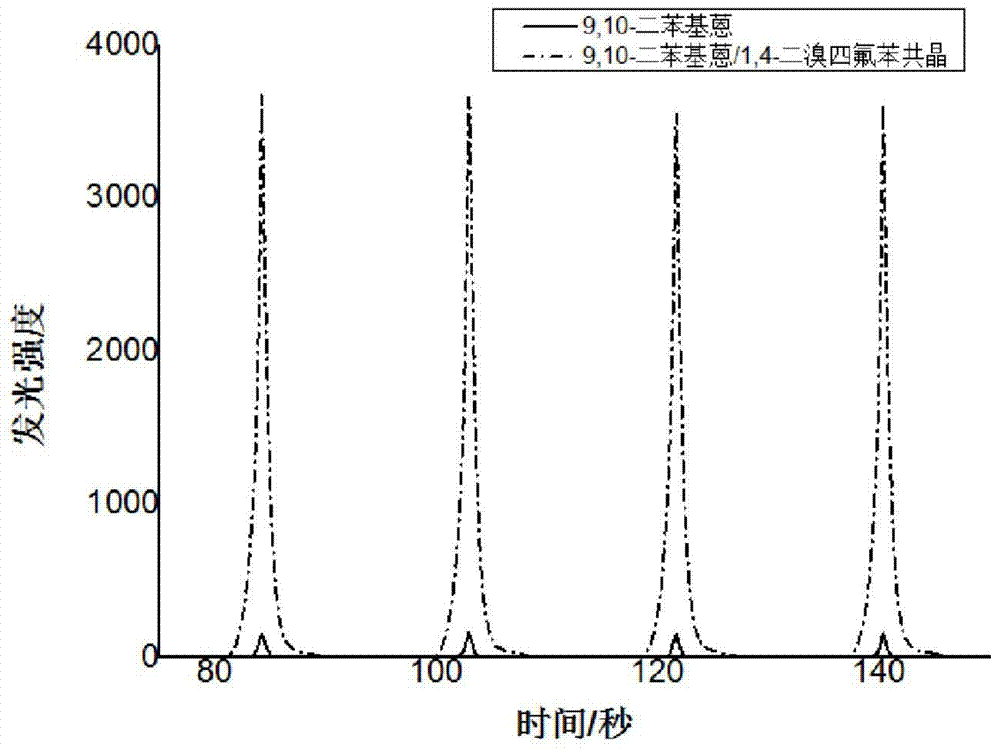A diphenylanthracene co-crystal material with electrochemiluminescent properties and its preparation method
A technology of luminescence characteristics, diphenylanthracene, applied in series 9 fields, can solve problems such as weak signal, unfavorable solid-state ECL application, limited detection, etc., to achieve the effect of optimizing electrochemiluminescence performance, broadening the scope of preparation, and broadening the application space
- Summary
- Abstract
- Description
- Claims
- Application Information
AI Technical Summary
Problems solved by technology
Method used
Image
Examples
Embodiment 1
[0025] 1) Weigh 0.0664g of 9,10-diphenylanthracene and 0.0544g of 1,4-dibromotetrafluorobenzene;
[0026] 2) Mix the two evenly, put them into a ball mill (Leicher, Germany, MM200), add 0.5ml of chloroform, and grind for 30min at 20r / s;
[0027] 3) Dissolve about 0.1 g of the ground powder in 15 ml of chloroform, place it at room temperature, and wait for the solvent to evaporate to obtain a single crystal product.
[0028] To characterize the product:
[0029] The crystal powder of the product was tested by PXRD, and the diffraction pattern showed that the target product was synthesized;
[0030] Single crystal X-ray diffraction analysis of the single crystal product shows that 9,10-diphenylanthracene and 1,4-dibromotetrafluorobenzene are bonded together through intermolecular hydrogen bonds to form a new crystal structure;
[0031] Using a three-electrode system, use potassium dihydrogen phosphate of pH=7.4 as a buffer to test the electrochemiluminescence intensity, showin...
Embodiment 2
[0033] 1) Weigh 0.0664g 9,10-diphenylanthracene and 0.0544g 44`-dibromooctafluorobiphenyl;
[0034] 2) Mix the two evenly, put them into a ball mill (Leicher, Germany, MM200), add 0.5ml of chloroform, and grind for 30min at 20r / s;
[0035] 3) Dissolve about 0.1 g of the ground powder in 10 ml of chloroform, place it at room temperature, and wait for the solvent to evaporate to obtain a single crystal product.
[0036] To characterize the product:
[0037] The powder of the product was tested by PXRD, and the diffraction pattern showed that the target product was synthesized;
[0038] The single crystal X-ray diffraction analysis of the single crystal product shows that 9,10-diphenylanthracene and 44`-dibromooctafluorobiphenyl are combined through intermolecular hydrogen bonds to form a new crystal structure;
[0039] Using a three-electrode system, use potassium dihydrogen phosphate of pH=7.4 as a buffer to test the electrochemiluminescence intensity, showing that the cocrys...
PUM
 Login to View More
Login to View More Abstract
Description
Claims
Application Information
 Login to View More
Login to View More - R&D Engineer
- R&D Manager
- IP Professional
- Industry Leading Data Capabilities
- Powerful AI technology
- Patent DNA Extraction
Browse by: Latest US Patents, China's latest patents, Technical Efficacy Thesaurus, Application Domain, Technology Topic, Popular Technical Reports.
© 2024 PatSnap. All rights reserved.Legal|Privacy policy|Modern Slavery Act Transparency Statement|Sitemap|About US| Contact US: help@patsnap.com









